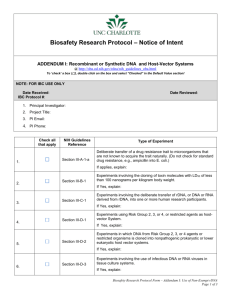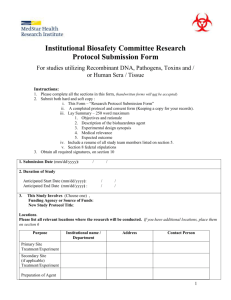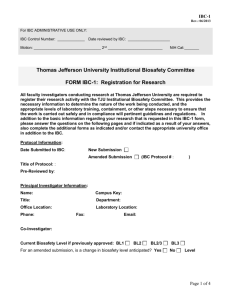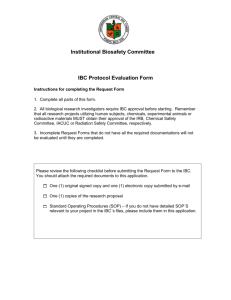NJMS PATHOGEN & TOXIC REGISTRY FORM
advertisement
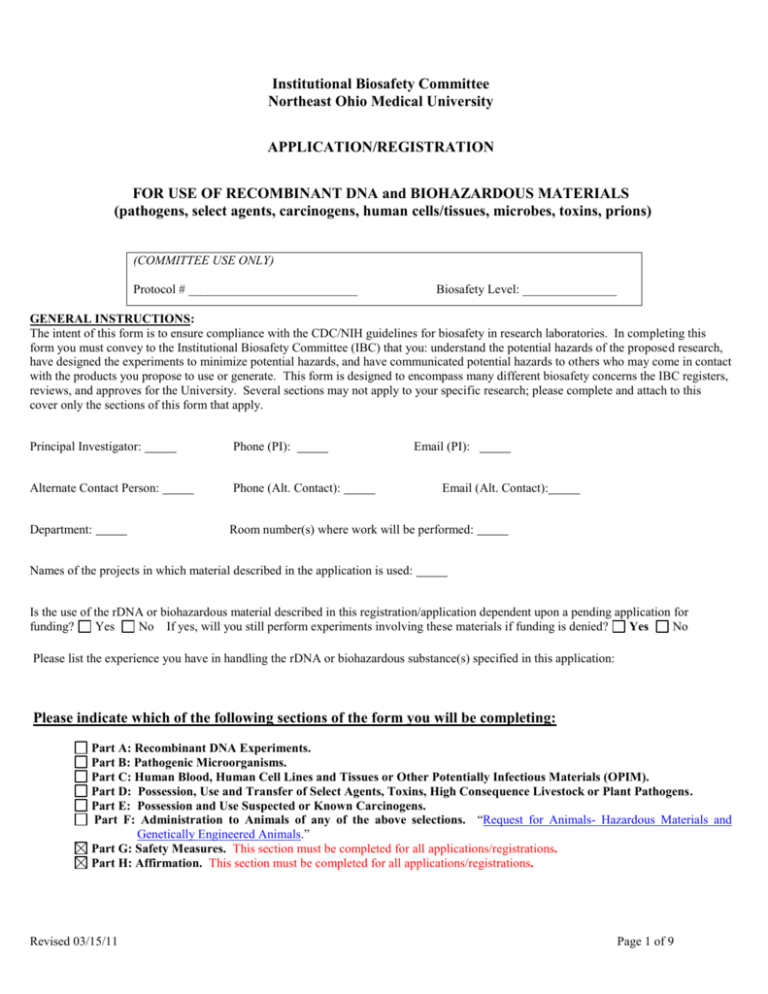
Institutional Biosafety Committee Northeast Ohio Medical University APPLICATION/REGISTRATION FOR USE OF RECOMBINANT DNA and BIOHAZARDOUS MATERIALS (pathogens, select agents, carcinogens, human cells/tissues, microbes, toxins, prions) (COMMITTEE USE ONLY) Protocol # ___________________________ Biosafety Level: _______________ GENERAL INSTRUCTIONS: The intent of this form is to ensure compliance with the CDC/NIH guidelines for biosafety in research laboratories. In completing this form you must convey to the Institutional Biosafety Committee (IBC) that you: understand the potential hazards of the proposed research, have designed the experiments to minimize potential hazards, and have communicated potential hazards to others who may come in contact with the products you propose to use or generate. This form is designed to encompass many different biosafety concerns the IBC registers, reviews, and approves for the University. Several sections may not apply to your specific research; please complete and attach to this cover only the sections of this form that apply. Principal Investigator: Phone (PI): Email (PI): Alternate Contact Person: Phone (Alt. Contact): Department: Room number(s) where work will be performed: Email (Alt. Contact): Names of the projects in which material described in the application is used: Is the use of the rDNA or biohazardous material described in this registration/application dependent upon a pending application for funding? Yes No If yes, will you still perform experiments involving these materials if funding is denied? Yes No Please list the experience you have in handling the rDNA or biohazardous substance(s) specified in this application: Please indicate which of the following sections of the form you will be completing: Part A: Recombinant DNA Experiments. Part B: Pathogenic Microorganisms. Part C: Human Blood, Human Cell Lines and Tissues or Other Potentially Infectious Materials (OPIM). Part D: Possession, Use and Transfer of Select Agents, Toxins, High Consequence Livestock or Plant Pathogens. Part E: Possession and Use Suspected or Known Carcinogens. Part F: Administration to Animals of any of the above selections. “Request for Animals- Hazardous Materials and Genetically Engineered Animals.” Part G: Safety Measures. This section must be completed for all applications/registrations. Part H: Affirmation. This section must be completed for all applications/registrations. Revised 03/15/11 Page 1 of 9 _______________________________________________________________________________________________________________ Part A: RECOMBINANT DNA Please identify the type of experiment described in this application/registration form by checking the appropriate box(s) below. (1) Check here if your experiment involves: Cloning of DNA encoding toxin molecules lethal to vertebrates at an LD50 of less than 100 ng/kg Human gene therapy Transfer of drug resistance to organisms not known to naturally acquire the trait, if such acquisition could compromise use of the drug to control disease in humans, veterinary medicine, or agriculture Risk Group 2, 3, or 4 agents as host-vector systems Cloning of DNA from risk group 2, 3, or 4 microorganisms into nonpathogenic prokaryotic or lower eukaryotic hostvector systems Use of infectious DNA or RNA viruses or defective DNA or RNA viruses in the presence of helper virus in tissue culture systems Production of transgenic and/or knockout animals at the NEOMED Animal Care Facility Buying transgenic and/or knockout animals from an outside vendor Use of viable rDNA-modified microorganisms involving whole animals or whole plants Administration of rDNA to animals More than 10 liters of culture Propagation and maintenance in tissue culture of r-DNA containing <2/3 of the genome of any eukaryotic virus in the demonstrable absence of helper virus, or of a virus that has been established to be non-replicating Propagation and maintenance in tissue culture of r-DNA containing a virus that has been established to be nonreplicating Formation of rDNA containing no more than 2/3 the genome of any eukaryotic virus rDNA that is not in an organism or virus DNA segments from a single non-chromosomal or viral DNA source DNA entirely from a prokaryotic host when propagated only in that host DNA entirely from a prokaryotic host when transferred to another host by well established physiological means DNA from a eukaryotic host when propagated only in that host or a closely related strain of the same species DNA segments from different species that exchange DNA by known physiological processes (2) Registration w/NIH required? (3) Registration w/IBC required? (4) IBC must receive registration Yes Yes Prior to initiation Yes Yes Yes Yes Prior to initiation Prior to initiation No No Yes Yes Prior to initiation Prior to initiation No Yes Prior to initiation No Yes Prior to initiation No No n/a No Yes Prior to initiation No No No Yes Yes Yes Prior to initiation Prior to initiation At initiation No Yes At initiation No Yes At initiation No No No No n/a n/a No No n/a No No n/a No No n/a No No n/a Please complete the following sections to describe your experiment. 1. Does the donor rDNA, RNA, cDNA source or its vector have any recognized or anticipated pathogenic, toxigenic or virulence potential for animals, plants or humans? a. If yes, explain: 2. 3. YES NO Quantity of Material to be used: a. < 1 Liter b. 1-10 Liter c. > 10 Liters Location in which rDNA research is to be conducted (building and room #): Revised 03/15/11 Page 2 of 9 4. Specify source and nature of the DNA sequence(s) to be inserted (genus, species, gene name): a. Will the inserted gene(s) be expressed? YES NO b. If yes, what are the gene product effects? Specifically identify its toxicity, physiological activity, allergenicity, oncogenic potential or ability to alter cell cycle: 5. Describe the virus, phage and/or plasmid used for constructing your recombinants (prokaryotic, eukaryotic): 6. Identify host cell(s) or packaging cell line in which recombinant vector will be amplified: 7. Is the vector replication competent? YES NO 8. Are any viral component(s)/sequence(s) present? YES NO YES NO 10. Is helper virus used? YES NO a. Specify type: 11. Is it a retrovirus? YES NO 13. Will you be cross-breeding transgenic animals or creating a new line? YES NO 14. Will human subjects be exposed to rDNA? YES NO a. 9. If yes, specify the nature of the viral component(s): Does the insert contain >2/3 of a eukaryotic viral genome? 12. What cells, tissues, animals, humans, insects or plants will be exposed to the recombinant? Indicate type of cell line and species: 15. Brief description of proposed research (please include enough information to describe project’s specific aims): Revised 03/15/11 Page 3 of 9 _______________________________________________________________________________________________________________ Part B: PATHOGENIC MICROORGANISMS To be completed by the Principal Investigator for all laboratories handling or storing pathogenic microorganisms (agents capable of causing disease in immune-normal, healthy adults and includes organisms classified as requiring work at BSL-2 or higher in the latest edition of either the CDC/NIH publication, Biosafety in Microbiological and Biomedical Laboratories or the NIH's Guidelines for Research Involving Recombinant DNA Molecules. 1. Name of Organism (genus, species, strain description): a. Is organism attenuated? Is a toxin produced? a. Work with toxin? 3. Is drug resistance expressed? A. If yes, indicate to which drugs: 4. Where is organism stored? Bldg: Room: a. Are Biohazard Warning Labels in use? 5. Building and room where organism is used? Bldg: 6. Is a stock culture prepared? 2. NO NO NO NO YES NO YES NO YES NO YES NO Room: If yes, indicate: a. Total volume of stock culture b. Volume alliquoted per individual vial c. Concentration /ml individual vial d. Maximum volume used in an experiment 7. Is organism inactivated prior to use? a. Specify Method: 8. Do you concentrate the organism in your protocol? a. YES YES YES YES Specify method: centrifugation precipitation filtration other: 9. Does the laboratory work with human blood or blood products, unfixed human tissue, or human or other primate cells? If yes, fill out Part C below. 10. Are cultures, stocks, and contaminated items decontaminated prior to disposal? a. Method: autoclave chemical disinfectant other (specify): Brief description of proposed research (please include enough information to describe project’s specific aims): Revised 03/15/11 Page 4 of 9 __________________________________________________________________________________________ Part C: HUMAN CELLS AND TISSUES Please list the cell lines and tissues that you will be using, attach additional sheets if needed. Include established human or primate ATCC cell lines and any other potentially infectious materials. Note: Use of human cell lines or human source materials may require registration with the Institutional Review Board (IRB). Please contact the IRB to determine if your protocol will require review. 1. 2. 3. 4. 5. 6. 7. 8. 9. Brief description of proposed research (please include enough information to describe projects’s specific aims) Please include room in which cells/tissues will be stored and used: _______________________________________________________________________________________________________________ Part D: POSSESSION, USE OR TRANSFER OF SELECT AGENTS, TOXINS, HIGH CONSEQUENCE LIVESTOCK PATHOGENS, AND PLANT PATHOGENS The University is required to register with the CDC or USDA for possession, use or transfer of any agents, toxins or pathogens appearing on the National Select Agent Registry list found at http://www.selectagents.gov/SelectAgentsandToxins%20List.html Please indicate below which select agent you are proposing to use: Revised 03/15/11 Page 5 of 9 ____________________________________________________________________________________________________________ Part E: CARCINOGEN USE Known Carcinogen Form (solid/liquid/gas) Quantity Storage Location Use Location Please provide a description of the process in which the carcinogen will be used: Emergency Exposure Procedures: (inhalation, injection, absorption) _______________________________________________________________________________________________________________ Part F: ANIMAL USE If you are using animals, please complete the “Request to Use Animals- Hazardous Materials and Genetically Engineered Animals”. _______________________________________________________________________________________________________________ Part G: SAFETY MEASURES Research will be conducted at Biosafety Level . Contact the Institutional Biosafety Committee Chair if you need assistance in determining the appropriate classification. Reference the CDC/NIH BMBL5th Edition available at: http://www.cdc.gov/od/ohs/biosfty/bmbl5/BMBL_5th_Edition.pdf 1. 2. Engineering controls: available to control significant aerosol generating steps for work requiring BL-2 containment or higher (e.g., centrifugation, vortexing, sonication, egg harvesting) Check all that apply: Indicate the engineering controls used to prevent potential contamination: a. Containment Suite (e.g., BL3) YES NO b. Biocontainment Animal Housing (if applicable) YES NO c. Class II Biological Safety Cabinet YES NO d. i. Type A (A1 or A2) or Type B (B1 or B2)? ii. Last date of biological safety cabinet certification (Mo/Yr): Centrifuge Safety Cups e. Other (please specify): NO Sharps: (e.g., syringes, scalpels, glass) used with BSL-2 and higher organisms must be minimized. Safer sharps MUST be reviewed and used whenever appropriate for work involving bloodborne pathogens. Consult the Safety Office for a list of EPA approved devices and manufacturers of “safer sharps”. a. b. c. 3. YES Will syringes, scalpels, glass, or other sharps be used? Has the research protocol been reviewed to eliminate or minimize the use of sharps where possible? Are sharps with integrated safety devices/mechanisms available and used? If yes, describe device (Type, Model, Brand): YES NO YES NO YES NO Personal protective equipment Please indicate any personal protective equipment IN ADDITION TO LAB COAT, GLOVES AND SAFETY GLASSES which are required to perform work for this project: It is assumed that general PPE (lab coat, gloves and safety glasses) will be required for ALL protocols under review. List other required PPE: Revised 03/15/11 Page 6 of 9 4. Decontamination/Disinfection/ Treatment of Infectious Waste: Indicate the disinfection method per application (see columns to the right): Disinfection Method Routine cleaning & spills Application 1. Solid waste Liquid waste Animal Carcasses Autoclave NA ( Requires certification. Consult the Safety office for training.) 2. 15% Bleach Solution *You must register your lab with the Safety Office if 15% bleach will be your SOLE method of treatment of infectious waste. NA 3. Incineration 5. a. Will radioactive infectious waste be generated? c. How will contaminated solid waste be disposed? YES NO Principal Investigator’s Assessment of Risk a. What is the most serious adverse event you can forsee as a result of this experiment? (For example: recombination, employee exposure, environmental release, activation of latent virus, etc.) b. How did you determine the appropriate biosafety level for this protocol? c. Please list the following information about your most recent literature search on the safety of the organisms, reagents and experimental procedures used in this protocol. i. What is the date of your most recent search? ii. Which databases did you search? iii. What keywords did you use? iv. Please describe any pertinent safety or hazard analysis findings: d. Is there potential for this material to be contaminated with an organism requiring a higher biosafety level? i. How would you determine if the material was contaminated with an organism requiring a higher biosafety level? YES NO YES NO YES NO ii. Is your lab equipped to perform such an evaluation? e. What was the source of this material (i.e., ATCC, colleague, other)? i. Can the sender provide background information or quality control data on the material? ii. Have you already obtained this documentation? Revised 03/15/11 Page 7 of 9 6. Medical Surveillance (check all that apply): 1) Employees have attended Bloodborne Pathogens (BBP) training within the past year. All potentially exposed employees have received Hepatitis B vaccine or proven immunity. Personnel have attended annual Laboratory Safety training. Personnel shipping and receiving biohazard material have attended annual training. Contact the Safety Coordinator if more information on training is required. 2) Additional vaccination/surveillance required for work on this project. Specify agents and special vaccination/surveillance requirements (attach sheets if necessary): 3) Individuals at increased risk of susceptibility to agent (e.g., preexisting diseases, medications, compromised immunity, pregnancy or breast feeding) have been referred to the Safety Office for counseling. 4) There is a known vaccine and/or therapy: 7. Project Personnel: Principal Investigators, use the following table to list all personnel (including any students) in your laboratory who handle or may otherwise be exposed to any of the rDNA, human cell lines, carcinogens, toxins,or microorganisms. Please attach additional sheets if necessary. Name Title Date of Last Date of Last Lab Signature* Bloodborne Safety Training Pathogen Training *indicates person who signed this form has been informed of potential hazards and safe work practices Please list the experience of the project personnel listed above in handling the biohazards contained in this proposal: _____________________________________________________________________________________________________________ Part H: AFFIRMATION I accept responsibility for the safe conduct of work with this material. I accept responsibility for ensuring that all personnel associated with this work have received the appropriate training on the hazards and the level of containment required to perform this research safely. I will report to the Safety Office any accident or incident that results in a potentially toxic exposure to personnel or any incident releasing recombinant DNA or other potentially hazardous materials into the environment. Principal/Responsible Investigator: Signature: Date: If you are using this biohazard (s) in the conduct of a currently funded project, name of sponsor (s): FOR COMMITTEE/CHAIRMAN USE Approval: Yes Signatures IBC Chairperson: Revised 03/15/11 Yes, approved with modifications *(see notes below) No Determined Biosafety Level: ________ Date:_________________ Page 8 of 9 Revised 03/15/11 Page 9 of 9



